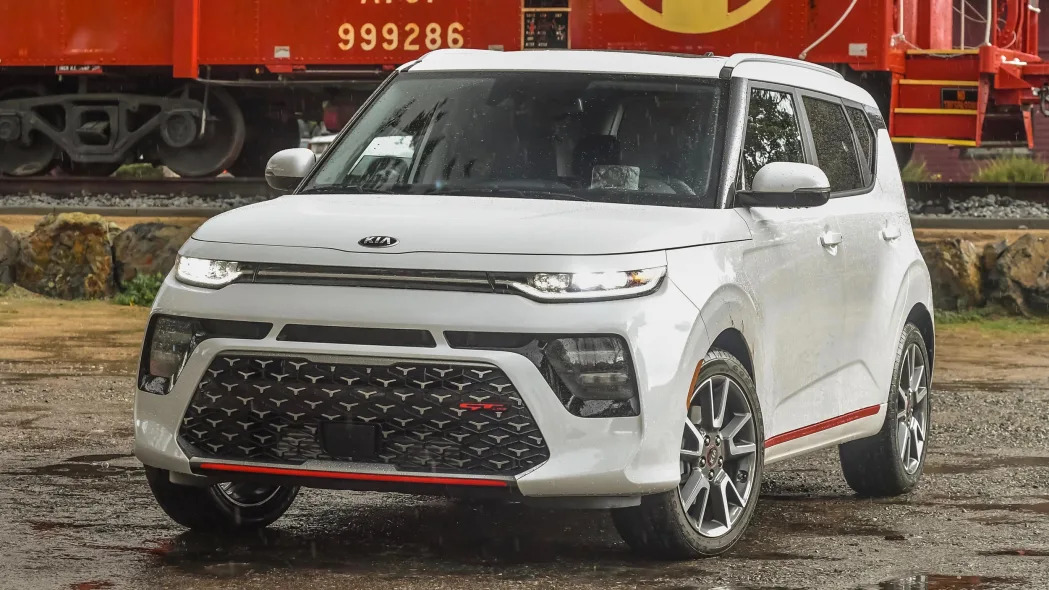-
TrimX-Line / GT-Line
-
EngineX-Line: 2.0L I4, GT-Line: Turbo 1.6L I4
-
Power2.0L: 147 HP / 132 LB-FT, 1.6L: 201 HP / 195 LB-FT
-
Transmission2.0L: CVT, 1.6L: 7-Speed DCT
-
DrivetrainFWD
-
Seating5
-
Cargo24.2 CU FT
-
MPGX-Line: 27 / 33, GT-Line: 27 / 32
-
Base PriceX-Line: $22,485, GT-Line Turbo: $28,485
It's hard to believe, but the Kia Soul first went on sale a decade ago, hitting the market for the 2010 model year to challenge the new-to-America Nissan Cube and the wheeled box pioneer Scion xB. We're not sure, of the three, we'd have put our money on the Soul to outlast the rest, but here we are. The xB and Cube are long dead, and the Soul is on its third-generation, ready to take on the latest crop of subcompact crossovers that have replaced the old boxes.
The new generation is completely redesigned from the ground-up, sporting bold but recognizable looks. Under the skin is a new standard engine, and the lineup features additional trim lines, each with unique styling. We tried out two versions of the new Soul, the crossover-inspired X-Line with a new naturally aspirated 2.0-liter engine, and the sporty GT-Line with the optional turbocharged 1.6-liter engine. What we discovered was a spunky, funky hatch that's a great choice all-around in one guise - and a questionable choice in another.
Kia Soul X-Line
The Kia Soul X-Line is roughly a mid-level model, starting at $22,485, and it features the powertrain that the vast majority of Souls will have: a 2.0-liter inline-four making 147 horsepower and 132 pound-feet of torque coupled to a CVT. That's a $4,000 step up from a base, manual LX, and the price difference is attributable to styling tweaks – plastic fender flares and silver-painted trim meant to evoke skid plates – plus the addition of blind-spot warning and rear cross-traffic warning. Despite the quasi-crossover looks, there's no extra ground clearance nor the option of all-wheel-drive. We don't think most buyers will mind, too much, since most Souls will probably never leave pavement anyway.
The four-cylinder engine is about par for the segment. Acceleration is sluggish with plenty of noise, but throttle response is snappy, and the sounds it does emit is pleasantly growly. Fuel economy for most CVT-equipped Souls comes in at 27 mpg in the city, and 33 on the highway, which matches the old naturally-aspirated 1.6-liter model's city economy and improves on the highway by 3 mpg. That puts it ahead of the Toyota C-HR and tied with the CVT-equipped Subaru Crosstrek. The EX version of the Soul manages an impressive 29 mpg in the city and 35 on the highway, coming close to matching the Nissan Kicks that gets 31 mpg in town and 36 on the highway. Choosing a manual in the Soul brings fuel economy down to 25 in the city and 31 on the highway.
The engine may be average, but the CVT impresses, partly because it spends its time simulating a silky smooth automatic. Popping it into manual mode lets you shift through predetermined ratios that never fluctuate. This not only reinforces the feeling of having real gears, but it makes the powertrain feel more responsive and lets you take advantage of engine braking. When you are ready to shift, the change comes smoothly and responsively.
We wouldn't normally go on about a CVT like this, but it was one of two key aspects that made this relatively plain Soul surprisingly fun on mountain roads around San Diego. The other was the Soul's cheerful chassis. On winding roads, the Soul barely leans, and it changes directions quickly and smoothly. The Soul remains pleasant off the mountain roads thanks to a well-damped ride that falls a bit on the firm side. The only drawbacks are numb, imprecise steering, and a bit of busyness over bumps that may be a side-effect of the Soul's torsion beam rear suspension. Neither were annoying enough to put us off the Soul.
The Kia Soul's driving experience is also enhanced by the hatchback's well laid out, comfortable interior. The high-seating position provides great visibility, and the high roof keeps you from feeling like your head is in the ceiling. There's plenty of adjustment in the wheel and seat, so a comfortable position is a breeze to find. While they don't have much shape, the seats are still comfy thanks to soft thick cushions that make the ride even more comfortable. Space is bountiful for all occupants, and your five-foot ten-inch author easily fit behind himself in the rear seats that feature a nice reclined shape and 38.8 inches of leg room. That happens to be more than the also capacious Subaru Crosstrek. Cargo space is also plentiful at 24.2 cubic feet. The infotainment system features a standard seven-inch screen and Hyundai and Kia's simple and effective operating system.
It's just a shame Kia didn't make this useful interior as characterful as the exterior. It certainly attempted to funk it up with triangular patterns in the doors, a squircle-shaped center stack and tweeters nestled against the air vents, but Kia rendered them all in shades of black or dark grey, hiding them even further in a colorless, drab interior.
Kia Soul GT-Line Turbo
Now we come to the other Soul, the GT-Line with the turbocharged 1.6-liter four-cylinder. Like the X-Line, the GT-Line sports unique body work with big grilles, deep spoilers, red accents and a sweet center-exit exhaust. But the focus here is the powertrain and the standard equipment.
At 201 horsepower and 195 pound-feet of torque, the turbo Soul is welcome in a class of serious slow pokes. And numbers aside, the engine is quite smooth, and the strong mid-range torque is highly entertaining in town. It's about all the Soul can handle, too, as we were noticing some torque steer when tramping on the throttle.
Power goes to the front wheels through a seven-speed dual-clutch transmission that's good, but not exemplary among similar transmissions. Gear changes are prompt and smooth, but not as fast as German units, and at take-off, clutch engagement isn't quite as quick. On the plus side, this Soul improves on its predecessor with the inclusion of steering wheel paddles. It'd be improved more with a manual transmission, and a Kia representative left the door open for one if the market demands it. Sadly, we doubt the market will demand it.
Kia also claims that the turbocharged GT-Line gets sportier suspension, but we didn't notice much difference in how it rode and handled. As we discussed with the X-Line earlier, that's not necessarily a bad thing, since the regular models strike such a good balance already.
The GT-Line's other attraction is that it has basically every possible feature available for the Soul. It has a standard sunroof, heated seats and steering wheel, adaptive cruise control, Harmon Kardon stereo, power driver's seat, heated mirrors, (deep breath) heads-up display, keyless entry, push-button start and dual-zone automatic climate control among others. It also gets the massive 10.25-inch infotainment screen that operates about the same as the smaller one, but, you know, bigger. All things combined, this is certainly the nicest Soul available.
Pricing
You may have noticed that we hadn't brought up pricing yet, and that's because it's what makes one type of Soul a solid value, and the other quite questionable. The clear value winner is pretty much any naturally aspirated Soul with cheapest starting under $19,000, and the most expensive starting just under $24,000. The X-Line we tried starts at $22,485. As such, any 2.0-liter Soul is right on par in pricing with most of the subcompact crossover competition such as the Toyota C-HR, Nissan Kicks, Ford EcoSport, Mitsubishi Eclipse Cross, and many more.
Then there's the turbo model that rings in a not insubstantial $28,485. That's a lot of money, and whether it's worth it will depend on what you're looking for in a vehicle. If you just want a loaded small crossover with healthy power, it's a good choice, especially considering that you can spend just as much money on much less powerful options such as the EcoSport and C-HR. But if you're looking for an entry-level hot hatch, it's a terrible deal. That same money could get you a Volkswagen GTI, Ford Focus ST or even a Hyundai Veloster N, all of which offer more power and better handling. If Kia decides to offer the turbo engine on a more bare bones Soul GT-Line, it might be more appealing to enthusiasts.
Final Thoughts
The subcompact crossover segment is so crowded it may be in violation of fire code, so it's difficult to stand out. But the Soul does stand out – a stylish little crossover with enough variants to appeal to just about any buyer. Not only that, but it's highly functional and it's surprisingly fun to drive. The only gripe is the Turbo's poor value proposition compared to some more fun vehicles at roughly the same size and price point – and that's partially forgiven by its ample power and standard equipment. But otherwise, the Soul line represents some offbeat fun and a good value.
Related Video:





















Sign in to post
Please sign in to leave a comment.
Continue